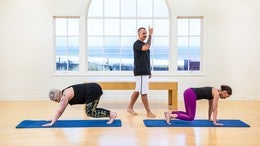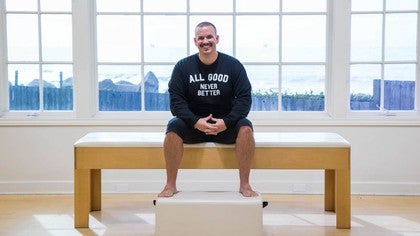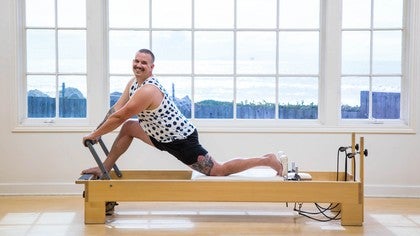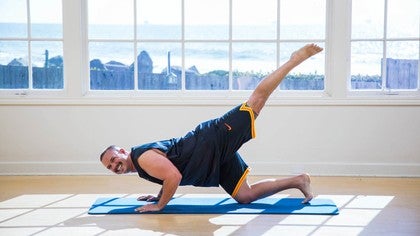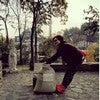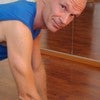Description
If you are returning to try this class again, James starts moving at about 2:33.
About This Video
Transcript
Read Full Transcript
Welcome back everybody. Uh, I'm your guide for this adventure James crater, and we're here with the reformer. I know that the reformer is the most beloved of all [inaudible] equipment and I like it too. I use it really specifically at my studio, and so when I was asked to come and do a reformer class, I thought, well, I'm going to show how I use it and what I do with it. There's not going to be a lot of tricks here. What we're going to utilize this for is as a very sophisticated body sensation. Proprioception tool. I see spring tension is artificial gravity.
So here we can have gravity coming this way or this way. We always have gravity coming this way, so we're going to play today on the reformer. My advice to you is as you watch me process through these exercises, these explorations don't use your brain to try and copy me use, and this is really cool. Use your heart to try and copy me. I just read it. I'm like so excited about this information that we have mirror neurons in our hearts. Mirror neurons are the parts of what I always believed our brain to be that uh, allow us to copy and mimic and explore things that we see other people exploring movement wise.
We have mirror neurons in our hearts for compassion and empathy and I personally think we probably also have mirror neurons in our hearts to know what feels good to us. So rather than doing what I do, use what I do as inspiration to do what you do, we're going to start off, I'm starting off on two reds in a blue. I'm on a balanced body reformer here and we're going to start off with some footwork. My goal for today is to weave you in and out of some standard looking [inaudible] exercises and then give you some inspiration on how to kind of play with this. My recommendation, if you have not yet, is to go back and watch the meditation video that I did on sitz bones meditation and primal streak stuff. We're going to be using some language from that that you're going to need to know. This is installment number two of that three part series. And coming up, we've got a mat class for you where we take all the stuff from lessons one, two and make it into a lesson three for you about human movement. So this is the cultivation stage of, of the exploration.
We had the emerging stage with the meditation cultivation stage where we're going to let the reformer reformer teach us something about ourselves. So again, two reds, one blue. We're just going to start off with uh, some footwork. So I'm going to lie down and I'm going to get started. So I'm just going to be here and are already like, I want my head up a little bit to start off with. So instead of doing the usual like squeeze here, push here, do that thing. I'm going to access my meditation. Can I allow my sits bones to be wide? Can I allow my to be wide?
Can I sense where the midline spaces and how much to the left and to the right, am I aware of? And that's going to be my opening. And then I'm just going to breathe for a moment and then I'm just going to start to push in and out. I'm not going to give myself a lot of cues here. Instead what I'm trying to do is make myself available for the lessons that the reformer and the movement itself is going to teach me. So as I move, I'm just going to talk you through my experience as I move automatically and if you go back to the meditation, my left side feels weird. My right side feels open, I'm aware it got the beautiful ocean and clouds back their left side, so I'm going to concentrate on just allowing my left sit bone to open up a little bit and automatically. That kind of helps me, so I'm just going to be here moving.
Then I'm going to go to balls of the feet and I'm just gonna first access some ankle movement. I'm going to decide on a good height for myself and then I'm going to move from there. Now you may have decided a different height for yourself. Sometimes I really like a really high heel here. Often. I'll just allow my heels to sink and can I keep them under to the best of my ability as I come in, I'm going to lift lower and go under few more times here. Then maybe I'll bring my heels together. Oh, for me, that just automatically brought my sits bones together, so because I'm aware of that, I'm going to just allow that to open up a bit. Check in with yours.
When you bring your heels together, does that squeeze your sitz bones together and can you just not, there's nothing right or wrong with it. It's just what can I create some options and then I'm going to come in and I'm gonna open up here. Do a few here. Just kind of checking in. It's a really neutral, easy wait, good. So all of that super familiar looking. Now here I've got a pile of these mini balls. When I use the ball, I typically will deflate it a good half to three quarters of the way. It doesn't matter. The size, doesn't matter the brand. Use it however you're going to use it. If you want it really big, if you want it really small in the studio too, I'll often use like a little Franklin balls or something to place right on the sacrum.
I'm using this today cause we're gonna use this a lot in our mat class and it's just good to have a cohesive experience. So I'm going to take this and I'm going to put it underneath my sacrum more or less. It's really big and I'm going to open up wide here. I'm going to go a little bit of, if you wanted to get anatomical with it, the end of the lumbar L five S one more so than the coccsyx or tailbone, just so that my sits bones can be wide here and I'm just going to be here for a bit and then I'm going to push out. My goal for myself is to kind of open up the front of my body and a little thing I like to do in my workouts and something that I encourage my students to do too, is can I relax my abs as I do that? There's nothing really great about or better about relaxed abs.
I think we just typically tend to squeeze too much, which blocks that emerging process that we covered. If as I push out my abs decide to contract themselves as they are, that's a whole other story. Can I just relax and allow my body to intuitively do what it needs to do? From there, I'm just going to get a little spiraling in. I'm going to lower my left hip down and push out.
Come back in right hip. Now I can stay there just doing this or, and here's where the cultivation phase comes in. Meaning I'm going to allow the reformer to teach me some lessons here as I go in and out. Can I allow my body to do what is called positive compensation? Meaning I'm going to allow my body to really begin to move here in ways that feel intuitive to move.
So again, if you're watching this and mirroring with your brain, this may not work for you. If you're watching this and mirroring with your heart, this is going to work for you. Can I just begin to move in ways that feel interesting to my own body.
I'm going to put my hands here works. I'm going to block my face for a moment, but you know what that looks like. So I'm going to go here and just kind of reach through this. I'm going to do an extra push through my arms, extra push and back. Then I'm going to decide to kind of come over onto my side and do an push and a look and then come back.
I'm going to do a push and a look and a come back rolling over to my hip and come back. As I go through that, I'm just accessing, well, are my sits bones allowed to be relaxed? Can I sense the space between the pelvis? And the head and can I get everything to move one more? Oh, all the way back in. Then just allow the knees to drop over to your right space and over to your left space.
Check back in which side do they drop more too. For me it's the right, the left little harder, which I can expect because I've already meditated around which space do I move better? Torwards then just bring yourself back to center. From there I'm going to drop my head rest back down and I'm going to go through a little bit of bridging here, so I'm going to come up and I'm going to go back down for your bridging. Do it the way that you know bridging to be done. Sometimes we come up planked sometimes it's articulated follow.
Follow your own school of thought. Here on the way down though, can I come down through each and every disc of the spine and just notice how that makes you feel. Then we're going to come back up. However it is. You come up and instead we're going to go, well, can I come down through my lungs, my kidneys, my stomach, intestines sits bones wide. From there we're going to come up and I'm going to change my mind. I'm going to go down my right lung, my right kidney, all the way down to my right, sit bone and allow myself to just find center.
I'm going to come up, rotate, left lung, left kidney, all the way down. Last one of this, we're going to come up. I'm going to access my meditation, allow the Headspace to be wide and come down through that spinal channel.
Uh, my body is telling me it would like to do some mermaid stuff, so we're going to have a little bit of a mermaid, right hand left hand out. We're going to press out and you're going to do your mermaid, whatever your mermaid looks like. If you're new to [inaudible], just have your leg kinda to the side. One in front, I'm on a red and a blue. Do a weight that makes sense to your body. Right hand is going to push out and I'm going to stretch over and then I'm going to come back up. Mermaid is one of my favorite exercises to play with and here's my thought process behind it. Someone invented this.
Someone said in order to do this thing called mermaid, you're going to put your hand here, you're going to reach and then you're going to do some specific stuff. That's great. That's a very precise way of doing something. It doesn't mean that it's the right way to do it. It doesn't mean that it's the right way to do it for your body. So this is me giving you permission to sort of play with that.
I'm going to guide you through a little bit. Here's what I think as I push out the first exploration is can I just allow my sits bones to be wide and stay where they're at and then come back up? How does that limit or influence what it is that I'm doing? So as I push out my sits bones are wide and they are where they are, whatever happens with this arm, great. Then I'm going to change my mind and instead I'm going to go, that's my right space over there.
So sitz bones can do whatever they want to do and I'm going to reach over to my right space and then I'm going to come back up. There's nothing wrong with that. It's just a choice. Then from there, I'm going to just watch my left hand and what if my left hand became a paper airplane and it just got to go wherever it wanted to go and my eyes just began to watch wherever my hand wanted to go. One more of those cause that feels good to me today. Good. Now from there, what if we just made the decision to put both hands on the foot bar and I'm going to push out and I'm going to come back in. I'm going to push out and then I'm going to make a decision.
I'm going to keep my arms straight. I'm going to keep pushing and I'm just going to bring my sits bones in, pushing out and back in. I'm going to make another decision and just let my head look somewhere else. As I do that and I'm spotting for me, I see a light up there. I'm just going to keep watching the light. Then I'm going to look over here. I'm going to look at that cloud over there and just keep moving in and out.
Simple enough, right? Let's do the other side, so again with this, it's just a generic layout. I put my hand here and here. Each school of thought has its own reasoning why it does mermaid the way it does mermaid. I'm just allowing for some positive compensation. What does my body wants to do? Does it want to reach
Then make some decisions for me, keep my arm straight and allow the sitz bones to come in. Then make some decisions with the eyes looking for clouds or the waves looking over at a light or looking for my own leg. The decision is yours to make. Okay? From there feeling the need to do some sort of split thing. So we're just going to go here and just kind of push out a little bit.
Maybe I even go here for a bit, something decently standard
From there, let's go into a nice stretch I have on a red and a blue. I'm going to do the easy version of knee stretch. I'm just going to sit back and I'm going to do my meditation, sitz bones wide Headspace, and I'm just going to push in and out. What I'm gonna do at first is just allow the Springs to inform me what the information or the information that I'm looking for right now is as I push out, can I relax my abs and a certain space out? I no longer can and I'm just interested to know where is that space for me it's right about here any further and I feel my abs have to pull up so I'm going to go out.
I'm going to be in that space and I'm going to see if I can relax and widen as my abs do their job.
I can even open up
So from there I'm just going to get my toes set up. Now with a tuck, my cue when my toes talk is I have five toes on each side. I've got 10 toes. Can I feel 10 toes as I press I have 10 toes that inform 10 fingers to lift. My eyes are going to watch open. Come back down. We're mirroring here what we did with the big shape, little shapes in knees, stretch, push through my legs. I can choose to watch a hand, let it go where it wants to go.
If you do a flex and appoint, do that here. If you go heels together. Great. And then what if just my left leg got to go out to the side a bit. What am I right
Do I feel safe and secure as I do this or do I get a little anxious? If I get anxious, just go back into my meditation.
I like to find my sits bones Lyft. Let it kind of round me a bit open up. And this next one I'd love to say I invented this, but this was actually from one of my students. I said, let's do leg circles. And she said, all right. And so she just did this and I liked it. Now go ahead and place your hands onto your shoulder blocks or um, the strapped poles. Whatever works best for you.
And as you take your legs to the right, can you let your ribs and everything go same over to the left. And can you give yourself permission to let your head go with it? Maybe even looking around the room
I'm going to get myself adjusted a bit so that it's not a peep show. We're going to lift up, open up and come back down. I can try different placements for my arms. [inaudible] my body prefers this for today. Once I'm up, I'm just going to allow my body to move side to side as I come down. Right? Lung, left lung, right lung, left, one going up, left lung, right lung, left lung, right lung. [inaudible].
Learning all the little spaces to open. One more this time I'm going to do that, but I'm going to open up wide, right foot, left foot, right foot, left foot all the way. I'm going to come up. I'm going to bend my knees. I'm going to make the decision to go parallel as I come down and I'm going to reach and then I'm just going to hang out here for a moment and just take some breath. Bring it all together. Hands are going to go here.
Make a decision with your legs that works for you. I'm just going to go some tabletop version right now. It was my arms lift and lower and then I can go, well, what happens if one leg reaches maybe even a foot flex? Can I wiggle my toes?
Asymmetrical arms, bent legs. We're just playing here. Maybe one leg reaches out and the other leg reaches out. Maybe I even get to roll to that side and roll to that side.
Okay. We're about to get into some more body weight exercises. We've got some long stretch coming up, some side work and then we're going to end in standing here in just a moment. So again, I'm going to go red and blue and I'm going to come here. Now again, lateral work super hard. I'm going to make the decision here to have this leg, my left leg up against the front shoulder block and my back leg up against this one right side. Easy for me. I know that from my meditation.
When you get to the left side, I don't know what's going to happen. So here we go. We're going to go here and we're just going to push out and then come back in. Right arm on back knee. Never leaves the mat pressing in and out. Then as I get more
I'm just tracking with my eyes where this hand wants to go. Other side, left hand is down. Let's do a little finger cross. Left hand is down, left foot is back, right foot is in front. Testing the waters, opening up, tracking where this wants to go. Bring it back in. Now that cues me into what's going on the left, what's going on the right.
So when I get here, I now know left side is doing. This right side is doing this totally fine. There's siblings left side and right side. Just need two different things so I'm going to go here. For me, I bring my right hand in a little closer.
My left hand goes a little wider, just works and I push in and out. It can be small or I could go big shape. I could come in and go. Little big, little big done. Last movement experience, standing side splits. So I'm going to choose, I'm going to go red into yellow, make your decision, drop your foot bar down however you'd like and then we're going to go up to standing here. One foot goes on, the other foot goes on again. Each school of thought has their own idea of what side splits is.
Do you, I'm just kind of testing the waters to begin with. Do I like this? Do I want to go out a little more? This feels good to me. So once you've made your base decision, kind of just play with it for me here. I can feel that I'm still not quite weighted over on the left, so I'm just going to allow the sip on to get wide. That feels better.
Well, I could have two paper airplanes that I track peripherally meaning out the side of my eyes. Both of them could go on the same direction. They could split apart. I can bring myself back in. I'm just exploring space. How comfortable am I in the space? Let's do the other side and see what's there, so I'm going to come off, walk around, see what goes on over here.
Baseline. This view just never gets old.
Can I allow my sits bones to be there for me? It's really interesting for me right now I have this thought urge to keep the card in. Why? I'm just going to let it open up a bit. Allow my sits bones to be opened up a bit. Take a couple of breaths. Think about what you just learned about your body, and then make a decision as to how to dismount coming all the way in, all the way off. So that's how, that's how I use the reformer as a really sophisticated informational tool to collect some data about how I feel today. Possibly warm up the body, learn to make some choices, create a safe and secure environment so that I can do some mat work, which is coming up next. So thank you for joining me for the mat class.
I really appreciate your time. Do the meditation. Do this. Join me for the mat class. It's coming up and I think it's pretty great. Thank you guys for joining us. Appreciate it. Thank you.
Mindful Movement: Centering Exploration
Comments
You need to be a subscriber to post a comment.
Please Log In or Create an Account to start your free trial.
